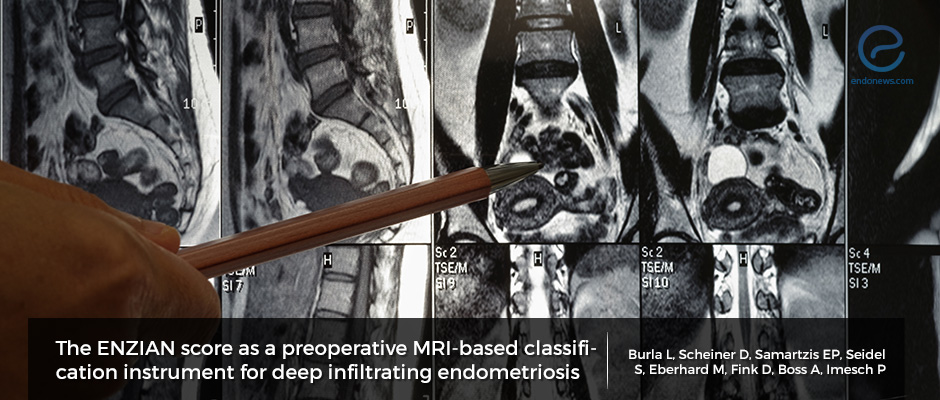MRI-based "ENZIAN" scoring system and intra-operative endometriosis findings
Apr 23, 2019
MRI ENZIAN scoring system holds promise as an adjunct tool for pre-procedural endometriosis surgery planning
Key Points
Highlights:
- The ENZIAN scoring system holds promise in enabling gynecologic surgeons to better plan an appropriate surgical treatment for patients with endometriosis.
Key results:
- The widely used rASRM score did not consistently agree (58%) with MRI findings and intraoperative results and tends to underestimate the severity of MRI findings.
- Unlike the rASRM score, the ENZIAN score takes into account the location of endometriotic lesions. Thus, the authors propose that it should be used in combination with the rASRM score for preoperative planning of DIE.
- From the 63 patients’ images, authors found 41 vaginal/rectovaginal space, 40 uterosacral/pelvic wall, 36 rectal/sigmoid colon, 14 adenomyosis, 7 bladder, and 14 intestinal (excluding rectal/sigmoid) lesions.
- Of all these locations, MRI had the highest sensitivity (>90%) for detecting “vagina and rectovaginal space” and “rectum and sigmoid colon” lesions.
- SAG T2 showed the highest diagnostic value, based on the Likert scale, with a mean of 4.4, followed by AX T2 (4.3), COR T2 (3.75), AX T2* (3.4), AX T1 pkm (3.3) and AX T1 (3.0).
What’s done here?
- This article aims to compare the preoperative MRI and intraoperative findings of patients with deep infiltrating endometriosis (DIE) by using a new scoring system called "ENZIAN", in order to see whether this tool can be beneficial for preoperative surgical planning.
Limitations:
- Further studies are required to validate the pre-procedural utility of the ENZIAN score for patients with DIE.
Lay Summary
Endometriosis is a chronic inflammatory disease whereby endometrial-like glands grow and invade the extra-uterine structures. Endometriosis may affect various parts of the body, including the peritoneum, ovaries, or retroperitoneum. Recently, non-invasive methods for detecting these lesions have included trans-vaginal ultrasound (TVUS) and magnetic resonance imaging (MRI) for pre-operative planning of patients undergoing surgery. However, compared to the gold standard of diagnostic laparoscopy, these imaging methods have not been found to outcompete laparoscopy in terms of sensitivity and sensitivity.
The "ENZIAN" score system is a new method for scoring endometriosis that invades the retroperitoneal organs (as is the case of deep infiltrating endometriosis (DIE). It was first introduced in 2005 and later modified in 2011 as a supplemental scoring system for patients with DIE.
This study performed by Burla et al., from the Department of Gynecology, University Hospital Zurich, Zurich, Switzerland, and published in Archives of Gynecology Obstetrics; included 63 female patients with surgically verified (intraoperative or biotic verification) DIE with pelvic MRI scans. The MRI scan was with a 3.0T scanner and several sequences were obtained. Using these images, radiologists then obtained each patient’s ENZIAN score. This score is divided into three main components; A (vagina and rectovaginal space), B (uterosacral ligaments and pelvic wall), and C (rectum and sigmoid colon) and are subdivided according to the extent of the lesions into 0 (no lesion), 1 (<1cm), 2 (1-3cm) and 3 (>3cm). Additional localizations are FA (adenomyosis), FB (bladder), FU (ureter, intrinsic), FI (intestine except rectum/sigmoid colon), and FO (other, e.g., diaphragm). The intraoperative findings were analyzed using a five-point Likert scale.
From the 63 patients’ images, authors found 41 vaginal/rectovaginal space, 40 uterosacral/pelvic wall, 36 rectal/sigmoid colon, 14 adenomyosis, 7 bladder, and 14 intestinal (excluding rectal/sigmoid) lesions. Of all these locations, MRI had the highest sensitivity (>90%) for detecting “vagina and rectovaginal space” and “rectum and sigmoid colon” lesions. Authors also found that there is a tendency to underestimate lesions preoperatively in MRI when compared to intraoperative findings (especially when size is borderline on the 1,2,3 scale). Additionally, the agreement of the rASRM score (a form of surgical endometriosis staging system) regarding stage I–IV in preoperative MRI compared to surgical findings was 58%. Regarding the clinical relevance of the different MRI sequences, SAG T2 showed the highest diagnostic value, based on the Likert scale, with a mean of 4.4. In the additional compartments FA, FB, FI, and FU, especially lesions in the compartment FB exhibited very good accordance (Sensitivity. 85.7%, Negative Predictive Value 98.3%).
Even though MRI has been increasingly used as a diagnostic instrument for DIE, and despite important proceedings, there is still no sufficiently standardized diagnostic protocol. Thus, a consistent standard for the evaluation of the diverse characteristics of endometriosis is needed for effective pre-surgical planning between the radiologist and gynecologic surgeon and reduction of recurrent interventions.
Research Source: https://www.ncbi.nlm.nih.gov/pubmed/30980276
imaging endometriosis MRI surgery gynecology

